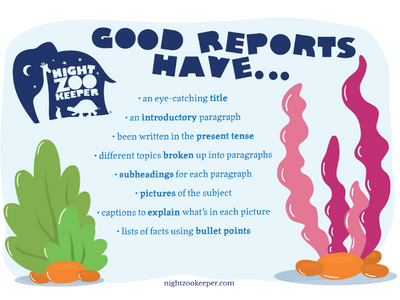Report Writing
Free report writing guide & worksheets

Home > Worksheets > Writing Styles > Report Writing
Report writing is a skill your child will need to develop to use in their life beyond - such as at university and/or in their professional career. Reports require your child to work on their research, analytical, and critical thinking skills. Learning this writing style teaches your child how to present and explain technical terms to readers and how to correctly use subheadings. This section of our website has free, downloadable worksheets to help your child improve their report writing skills.
Let’s get into what report writing is, what the report writing process looks like, and how you can help your child improve their report writing skills!

What is report writing?
Report writing is a formal writing style that has specific features, and requires attention to detail and strong research skills. Children will learn how to write a good report in their late elementary/primary school years, as it calls for a higher level of understanding and writing skills. Reports are used to make sense of facts, such as historical events, the results of an investigation, and to offer background information and insights on specific topics.
There are many types of reports used for a variety of reasons and objectives, including:
- Book reports
- Business reports
- Academic reports
While your child will not be asked to write a business report, they’ll likely come across this writing style when analyzing a book they’ve read in class, or by being asked to write a report on their favorite movie character. It’s important to note that report writing goes beyond English lessons, being used in other subjects, such as history and science.
How to write a good report
A good report follows a specific format with particular features, including:
An eye-catching title
Using an eye-catching title in report writing helps capture the reader’s interest right from the start. A strong title gives a hint about the topic, sparking curiosity and encouraging readers to dive into the details. For children, learning to create effective titles also enhances word choice and creative thinking, helping them consider how to best convey the focus of their work in a few engaging words. A well-chosen title not only grabs attention but also sets a professional tone, showing that the writer has thought carefully about the main idea of their report.
An introduction
Including an introductory paragraph in report writing gives readers a clear sense of what the report will cover and why it’s important. For young writers, crafting an introduction is an opportunity to practice organizing their thoughts and presenting the main topic in a way that captures attention. A strong introduction also provides essential background information, setting the stage for the details that will follow. This helps readers stay engaged and better understand the focus and purpose of the report from the very beginning.
The present tense
The present tense is used to express general truths and facts, which is why it is used in report writing.
Subheadings
Subheadings are similar to titles in that they give names to the specific sections of writing. The heading is the main title of a piece of writing, whereas the subheadings help divide up specific sections of that same report.
Subheadings are useful because they help organize a piece of writing by dividing the main body of the report into its main points. They should be clear and relevant to the content that it’s in the paragraphs following the subheading. Using subheadings in report writing gives your readers a better idea of what they will be reading about before they begin each section, which is why they’re so helpful!
Images
Adding images to a report helps make information clearer, more engaging and easier to understand. For young readers, images can highlight key points, explain complex ideas, or provide examples that support the main text. Including visuals also adds interest, encouraging the audience to explore the report more thoroughly. By carefully selecting images that relate to their topic, children can boost their report’s impact and make their writing more effective.
Fact lists
Including a fast list in a report helps children present key information clearly and allows readers to quickly find important details. This structure also keeps the report organized, making it easier for your child’s audience to remember essential points.
Report writing tips
Here are our top tips for your child when writing reports:
- Get your child to pick a topic they’re interested in (if they can pick their own topic)! Reports require a lot of information so ideally, it should be a topic they’d want to write a lot about.
- Report writing requires research. What key points should definitely be included in this report?
- Can the information gathered be broken down into subsections or different paragraphs?
- Are there any supporting materials that can be used in the report? These include images, graphs, or any other factual or visual information that may help to reinforce the importance of the main points.
- Your child should use bullet points and lists, as they can be helpful if there are a lot of facts that need to be included in order to form a good report.
- Proofread and check that the facts and technical terms included are correct!
Report writing prompts
If your child is struggling to come up with a topic they feel inspired to write a report about, no need to fret! Here are five report topics your young writer can choose from:
- What’s your favorite animal? Research and write a report about that animal, making sure to include a lot of information and facts.
- Choose one planet in our solar system, besides Earth. Research and write a report about your chosen planet!
- Pick a holiday you would like to know more about. Research its history and write a report about why people celebrate that holiday!
- Research the author of your favorite book. Write a report on their life and career!
- Pick a natural disaster to write about. Research your chosen natural disaster and write a report on it!
Free Report Writing Worksheets
Now that we’ve discussed the basics of report writing, your child should be ready to give this writing style a try! This free resource explains the entire report writing process, from different title pages, to how to organize contents of the report, to how to end the text. We’ve even included a template for your child to use!

How Night Zookeeper can help

Our reading & writing program for kids makes learning fantastically fun! In fact, the first task on the program helps children build their knowledge and understanding of the report writing process. Children are tasked with creating an original character for the Zoo, and are then asked to write a report about this new creature! This is the start of a fantastically fun learning adventure in the magical world of the Night Zoo...
More Writing Styles
Related content


Make Reading & Writing Fantastically Fun!
- Award-winning reading & writing program for kids
- Improves spelling, grammar, punctuation & vocabulary
- Over 1,000 different learning games and activities



